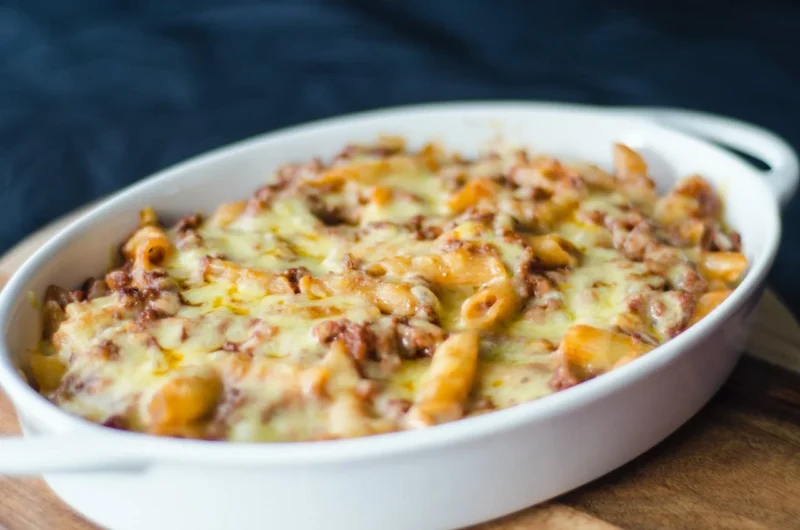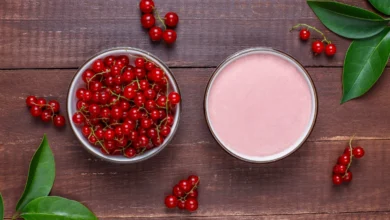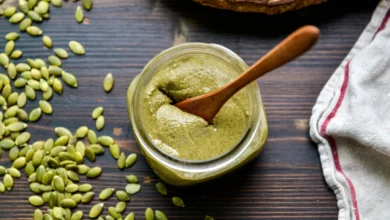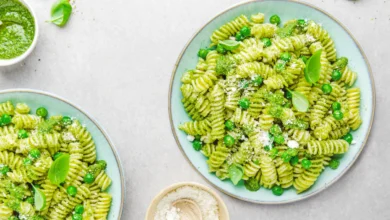While rummaging through my pantry one day, looking for something to whip up for dinner, I came across a little jar of pesto that had been languishing in the back for who knows how long. I also happened to have half a bag of macaroni leftover from a previous meal. A lightbulb went off – maybe I could blend the pesto into a béchamel sauce to create a cheesy pasta dish with a little twist. I cooked the macaroni according to the package instructions, then mixed it with handfuls of frozen spinach to add color and nutrients. In a saucepan, I whisked together butter, flour, and milk to make a smooth roux base. Once thickened, I stirred in the jar of pesto and a dollop of plain Greek yogurt to lighten the creaminess. The blend of herbs and yogurt balanced the rich sauce perfectly. I tossed the sauce through the mac and cheese, sprinkled on some grated Parmesan and enjoyed the unexpected fusion of flavours. The creamy pesto mac and cheese became a new favorite in my recipe repertoire.
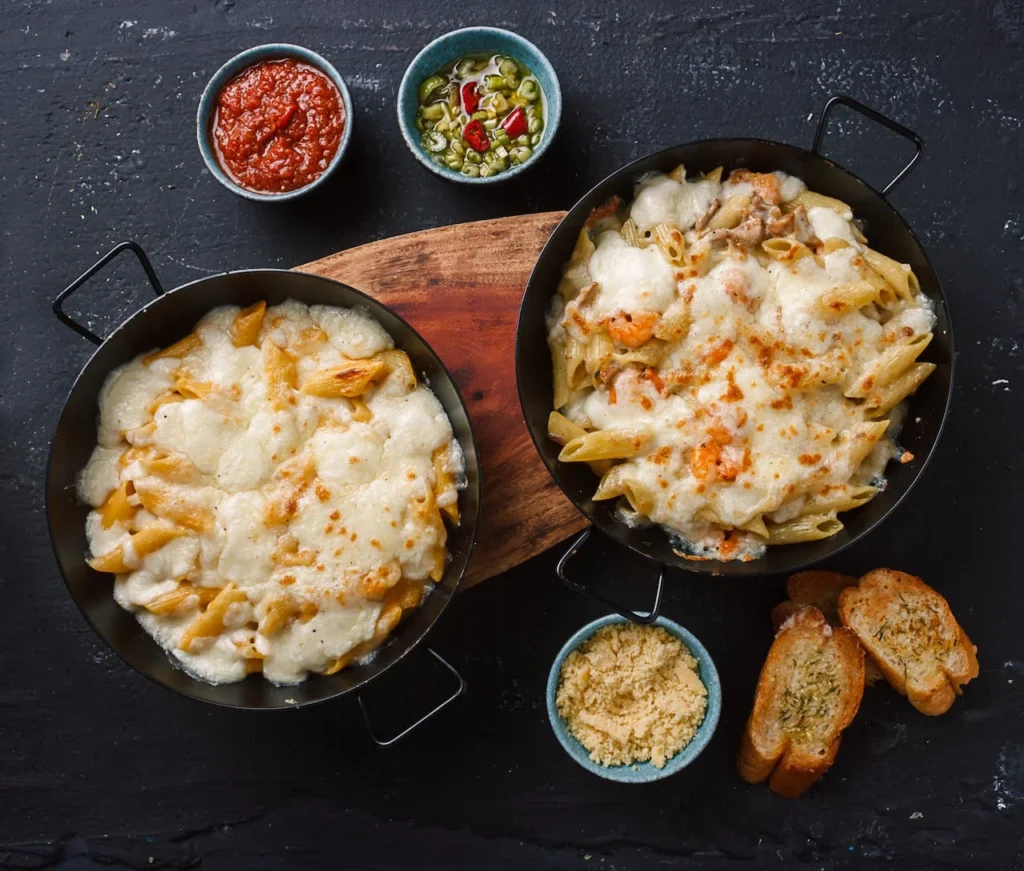

Contents
- Pesto Mac and Cheese
- Pesto Mac and Cheese
- Ingredients
- Directions
- Notes
- Can I make this into baked mac and cheese?
- Should I heat pesto before adding it to mac and cheese?
- How do I make pesto mac and cheese ahead of time?
- Does cheese go well with pesto?
- What does pesto pasta go with?
- What does pesto cheese taste like?
- What do Italians eat pesto with?
- Which pasta is better with pesto?
- What is pesto made of?
- Can I eat pesto pasta every day?
Pesto Mac and Cheese
Let’s learn how to make it, use it according to different occasions. We will also understand some variations that we can use.
What is Pesto?
Pesto is a type of sauce that originated in Genoa, Italy and is popular among many people. The classic style of pesto uses fresh basil, olive oil, pine nuts and Parmesan cheese. Basil is the defining herb in authentic pesto, along with nutritional vegetables like sundried tomatoes, bell peppers and mushrooms sometimes blended in for color and flavor variation. While basil pesto reigns as the most common version, other leafy greens like Spinach can stand in for a change in taste. The ingredients are finely chopped or blended to form a thick but spreadable sauce. Beyond pasta, pesto adds a pop of flavor to roasted vegetables, grain dishes, pizza, chicken or simply spread on toasted bread. Its intense herbaceous flavor enhances any meal it’s paired with.
Equipments
- Whisk
- Measuring Cups Spoons
- Liquid Measuring Cup
| Ingredient | Amount |
| Uncooked macaroni | 2 cups |
| Butter | 2 Tbsp |
| All-purpose flour | 2 Tbsp |
| Whole milk | 2 cups |
| Grated Parmesan | 1/2 cup |
| Basil pesto | 1/4 cup |
| Salt | 1/2 tsp |
| Freshly cracked black pepper | To taste |
| Frozen spinach | 1/2 lb |
What Kind of Pesto is Best?
While the classic basil pesto reigns supreme, the pesto recipe is quite flexible. Using different greens or flavour combinations results in tasty twists on the Italian sauce. For this mac and cheese, I used a store-bought basil pesto for convenience. However, getting creative by making your own homemade version allows you to control ingredients like swapping in kale or sun-dried tomatoes. As long as you have a good flavour profile with herbs, nuts, cheese and olive oil, you’re on the right track. In fact, you could practically make pesto out of anything green! Be adventurous and experiment with different things you already have on hand to do. At the end of the day, as long as the ingredients are blended together smoothly in a food processor, the result will be a wonderful pesto that enhances any dish it’s paired with.
How to Use Leftover Pesto
Pesto is such an expensive and potent ingredient that it’s ideal to find multiple uses for any jar extras. A few 1/4 cup servings can easily dress up various recipes over time. Some inventive ways to use leftover pesto include creating: Sheet Pan Pesto Chicken Dinner, Pesto Stuffed Shells, One Pot Creamy Pesto Chicken Pasta, Pesto Grilled Cheese with Sun Dried Tomatoes or Quick Fix Broccoli Pesto Pizza. Not only are these recipes full of robust flavor, but they creatively use up those odds and ends clinging to the sides of the container.
For people who buy pesto in bulk but don’t use it all at once, leftovers can be portioned and frozen. Simply spoon a tablespoon or two into each division of an ice cube tray, then transfer the frozen pesto cubes to a sealed freezer bag. That way, you’ve got single-serving bursts of pesto perfection to drop into pastas, salad dressings or sauces down the line. A little goes a long way thanks to pesto’s potency.
What Else Can I Add to Pesto Mac and Cheese?
While this basic recipe delivers creamy pesto goodness, feel free to customized it to your preferences. A handful of diced sun dried tomatoes stirred into the pasta adds sophistication. Shredded rotisserie chicken blended into the sauce turns it into a heartier meal. Toppings like crumbled feta, crisp bacon bits, or buttered breadcrumbs sprinkled over the top take the mac from side to main in an instant. Get creative with whatever ingredients you enjoy most – this recipe is easy to tweak simply by folding extras directly into the pasta as per the recipe directions, or by finishing individual servings with favorite mix-ins.
How To Store Mac and Cheese
- You can also store portions of leftover Pesto mac and cheese in an airtight zippered bag or container before chilling. For longer storage, individual servings can also be frozen for 2–3 months using the same storage method and dating containers on the outside. Alternatively, you could portion the mac and cheese into a homemade “pesto mac and cheese box” for lunch the next day.
- To thaw frozen portions, allow overnight in the refrigerator until firm but spreadable. Freezing doesn’t ruin the pasta’s texture as much as the heating process would, though some moisture accumulated may need draining.
- To reheat cold mac and cheese, gently warm it in a pot over medium-low heat, stirring occasionally. You can also refresh flavours by adding a sprinkle more salt, pepper, or ingredients like pesto if desired for an almost whole new recipe.
How to Freeze
To enjoy later, this recipe also freezes well in individual portions for quick weeknight meals. Simply portion the pesto mac and cheese into labelled Ziplock bags, pressing out excess air before sealing closed. You can store in the freezer for upto 3 months. When ready to eat, let the frozen pasta thaw overnight in the refrigerator before gently reheating on the stovetop or microwave until hot throughout. Freezing locks in the flavour, so this is an easy make-ahead option for busy schedules.
What to Serve with Pesto Mac and Cheese
This creamy, cheesy basil pesto macaroni is indulgent yet balanced with the bright fresh herb flavours. Some tasty sides that pairs well are: warm bread to soak up extra sauce, or tossed veggies for lighter fare. For the complete meal, serve the pasta with cheesy pull apart bread, cheesy focaccia or Parmesan crusted Hawaiian rolls. Some roasted veggie companions could include roasted Brussels sprouts, roasted potatoes or spicy firecracker broccoli for color and crunch. The choices are endless depending on appetites – enjoy!
RELATED: Fresh Oregano Pesto
RELATED: How To Freeze Gnocchi
Nutrition
| Nutrient | Amount per 1 cup (1/4 of recipe) |
| Calories | 333.58 kcal |
| Carbohydrates | 39.75g |
| Protein | 12.33g |
| Fat | 14.08g |
| Sodium | 665.92 mg |
| Fiber | 2.75g |
Some Suggested Variations:
In addition to taste, pesto pumps up this pasta dish with heart healthy fats, fibre and antioxidant-rich basil and garlic. The spinach adds nutrients too. Busy home cooks looking for an easy nutritional weeknight meal may find a “pesto mac and cheese Aldi” frozen option provides a similar nutrient profile. Just be sure to check the sodium content.
Feel free to substitute other types of pesto in this recipe to change up the flavor profile. For example, a “red pesto mac and cheese” made with sun-dried tomato pesto delivers deep, savory notes sure to please pesto lovers. Get creative with different herb-inspired mixes.
Pesto Mac and Cheese
Course: PastaCuisine: Italian-inspired6
servings5
minutes15
minutes333
kcal20
minutesHere is the recipe ingredients, and instructions. You can also print the recipe for your ease.
Ingredients
2 cups uncooked macaroni
2 Tbsp butter
2 Tbsp all-purpose flour
2 cups whole milk
1/2 cup grated Parmesan
1/4 cup basil pesto
1/2 tsp salt
Freshly cracked pepper
1/2 lb frozen spinach
Directions
- Thaw the frozen spinach and squeeze out excess water. Set aside.
- Bring a large pot of water to a boil. Cook the macaroni for 8–10 minutes, until tender but still firm to the bite. Drain in a colander and set aside.
- To prepare the sauce, melt the butter in a small sauce pot over medium heat. Whisk in the flour and cook for 1 minute until a creamy paste forms and bubbles. Whisk in the milk gradually and simmer until thickened, about 5 minutes.
- Remove from heat and stir in the Parmesan, pesto, and spinach until smooth. Season with salt and a generous grind of fresh black pepper.
- Add the cooked macaroni to the sauce pot and stir gently until fully coated and heated through. Serve immediately.
Notes
- The fresh basil pesto adds bright herbal flavor that balances the richness of the cheeses. For extra nutrition, spinach is stirred into the creamy sauce. This mac and cheese can be made ahead and reheated with a splash of milk to loosen the sauce as needed.
Conclusion
Whether made with the classic basil pesto or experimenting with sun-dried tomato or vegan variations, this recipe transforms simple macaroni into a hearty and flavorful meal with just a few additional ingredients. The versatility of pesto mac and cheese makes it a great choice for any night of the week, satisfying both dietary preferences and cravings for familiar or novelty pasta dishes alike. With countless customization options, it promises to become a new family favorite.
Can I make this into baked mac and cheese?
Yes, you can absolutely make this into a “pesto mac and cheese bake”. Simply pour the cooked macaroni and pesto cheese sauce into a greased 9×13-inch baking pan. Sprinkle breadcrumbs and Parmesan cheese over the top and broil for 3–4 minutes until the topping is golden brown.
Should I heat pesto before adding it to mac and cheese?
There’s no need to heat the pesto before adding it to the pasta and cheese sauce. The residual heat from the just-cooked pasta and hot sauce is enough to gently loosen and seamlessly incorporate the pesto.
How do I make pesto mac and cheese ahead of time?
You can make the pesto mac and cheese up to 2 days in advance. Store in an airtight container in the refrigerator until ready to serve, then reheat gently over low heat on the stovetop, adding a splash of heavy cream or milk to loosen the sauce if needed.
Does cheese go well with pesto?
Cheese and pesto are a delicious pair in mac and cheese. Variations like Gruyère, white cheddar, Parmesan and Gouda all work well, with mild or medium flavoured cheeses allowing the basil pesto’s strong flavour to shine through.
What does pesto pasta go with?
Pesto pasta pairs well with a sliced bread like rosemary olive oil bread or no-knead focaccia. It’s also scrumptious with sautéed veggies like zucchini, roasted mushrooms or broccoli and roasted carrots.
For heartier appetites, try turning this into a full one-dish meal by adding chicken to the baking dish. You can simmer or shred leftover roast chicken, grill chicken breasts or bake chicken tenders on the side. Once cooked, layer the “pesto mac and cheese with chicken” in a baking dish, top with more cheese and breadcrumbs and broil until golden. The savory chicken pairs perfectly with the rich, herbed pasta.
This pasta dish is quite flexible and open to personalization. For dairy-free diners, cashew butter or cauliflower make a creamy substitute for the cheese. Simply replace the butter and milk with olive oil and nut milk. Add cooked white beans for extra protein. A sprinkle of nooch (nutritional yeast) over top delivers savoury “vegan pesto mac and cheese” flavour. Experimenting with creative variations keeps mealtime interesting.
What does pesto cheese taste like?
Properly made pesto shouldn’t taste muddy – each flavour component like the fragrant basil, pungent garlic, buttery olive oil, sweet pine nuts and tangy cheeses should be identifiable and balanced, with the basil as the star perfume.
What do Italians eat pesto with?
In Italy, pesto is enjoyed as a perfect sauce for trofie (a traditional short Ligurian pasta), lasagna, potato gnocchi and topping for soups like minestrone. It’s also used to enhance the flavour of pasta dishes and served with fish fillets.
Which pasta is better with pesto?
When serving pesto with uncooked pasta, choose a shape that won’t overwhelm the oil-based sauce like fusilli, bucatini, capellini, or spaghetti. Longer cuts like fettuccine also work well.
What is pesto made of?
Traditional pesto is made by combining fresh basil leaves, garlic, pine nuts, olive oil, salt and hard cheeses like Parmesan or pecorino. It’s usually prepared using a mortar and pestle but also in a blender or food processor.
Can I eat pesto pasta every day?
While pesto is delicious, you’ll want to be mindful of its high sodium content – typically around 500 mg per serving. The 2020-2025 USDA Dietary Guidelines recommend no more than 2,300 mg of sodium per day. It can be hard to stay within guidelines if eating pesto pasta every day.


